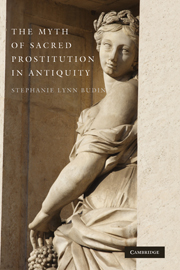Book contents
- Frontmatter
- Contents
- Acknowledgments
- Abbreviations
- THE MYTH OF SACRED PROSTITUTION IN ANTIQUITY
- 1 Introduction
- 2 The Ancient Near Eastern Data
- 3 The So-Called “Evidence”
- 4 Herodotos
- 5 In the Footsteps of Herodotos: Lucian and “Jeremiah”
- 6 Pindar Fragment 122
- 7 Strabo, Confused and Misunderstood
- 8 Klearkhos, Justinus, and Valerius Maximus
- 9 Archaeological “Evidence” from Italy
- 10 The Early Christian Rhetoric
- 11 Last Myths
- Bibliography
- Index
- Index Locorum
9 - Archaeological “Evidence” from Italy
Published online by Cambridge University Press: 18 August 2009
- Frontmatter
- Contents
- Acknowledgments
- Abbreviations
- THE MYTH OF SACRED PROSTITUTION IN ANTIQUITY
- 1 Introduction
- 2 The Ancient Near Eastern Data
- 3 The So-Called “Evidence”
- 4 Herodotos
- 5 In the Footsteps of Herodotos: Lucian and “Jeremiah”
- 6 Pindar Fragment 122
- 7 Strabo, Confused and Misunderstood
- 8 Klearkhos, Justinus, and Valerius Maximus
- 9 Archaeological “Evidence” from Italy
- 10 The Early Christian Rhetoric
- 11 Last Myths
- Bibliography
- Index
- Index Locorum
Summary
This short chapter is furnished in the interest of thoroughness and to correct some popular misconceptions about sacred prostitution in central Italy. The two regions in Italy once implicated in the sacred prostitution debate on the basis of physical remains – Etruscan Pyrgi and Italic Rapino – have since been reconsidered, so that few scholars still consider these regions to be associated with sacred prostitution. Nevertheless, it is worthwhile to look at the history of the sacred prostitution debate at Pyrgi and Rapino for two reasons. On the one hand, there are still a number of publications available that discuss sacred prostitution as having been practiced at these sites, and thus there is still the need to banish that specter in the literature (especially with Pyrgi). On the other hand, the ways in which sacred prostitution came to be associated with these two areas offer a fascinating insight into how this vicious cycle functions. For, in the absence of literary testimonia, the sacred prostitution idea only emerged in association with Pyrgi and Rapino through some rather gratuitous circular reasoning and apparent wish-fulfillment.
PYRGI
The suggestion that sacred prostitution occurred at ancient Pyrgi brings the sacred prostitution debate into a whole new community: the Etruscans of Italy. The idea that sacred prostitution might have existed here has at its base, no doubt, the fact that the Etruscans, like the Greeks, were heavily influenced by the Phoenicians during the early evolution of their society.
- Type
- Chapter
- Information
- The Myth of Sacred Prostitution in Antiquity , pp. 247 - 259Publisher: Cambridge University PressPrint publication year: 2008



